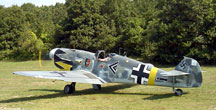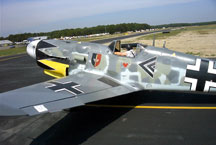|
Engine Run #16 & Ground testing
On August 28th, 2001, weather V.F.R. OAT 78 deg.
Purpose of Test
1. Determine if the changes to the Cockpit seat was helpful in ground
handling of the aircraft.
2. Changed the seals in the canopy glass and installed stop springs.
3. Handling of aircraft at medium taxing speed.
4. Maneuverability of the pilot while secured in shoulder and seat
belt harness.
Ground personal
Chase vehicle operator Gotfried Dulais. Radio operator, Emil Cassanello.
Ground fire safety personal, Ron Spencer, Phil Deluca, Charles Geier,
photographer. Pilot Al Rubenbauer. Chase fire truck supplied and operated
by Brookhaven Airport.
At 09:47 pilot was secured into the seat, little uncomfortable reaching
toward the starter, we feel it's something the pilot must get used
to.
At 09:52, engine start at 600 RPM, one minute later increased to 1200
RPM, which caused the wind-stream to again cause the canopy to break
and lay to the side of the fuselage. After emergency shut down and
removal of the canopy and a conference with ground personnel we decided
to run the aircraft without the canopy.
At 10:05 restarting the engine at 1200 RPM, she sounded good. All
gauges were working, and the throttle was responsive. (The noise and
wind without the canopy was almost impossible to handle).
After a few bumps, the radio became loose and was not transmitting.
I could only receive. The radio was working fine the day before and
had no problems. We believe that the seat for the radio was not making
contact. Also some type of stop should be made to hold the radio in
place.
After removing the tire chucks I began slow speed taxi on the grass
to the end of the field. Within a few minutes the aircraft was traveling
at medium speed, making S turns and I felt confident in handling the
aircraft. I feel that the changes that were made to the seat worked
well.
Each time I made a 180 degree turn, I stopped, holding the brakes
while increasing the RPM to 2500, I could feel the aircraft wanting
to break loose. ( I was tempted)
At 10:56 the engine was shut down.
|





|




